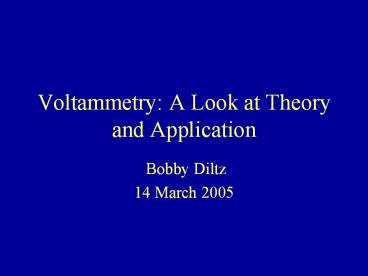Voltammetry: A Look at Theory and Application - PowerPoint PPT Presentation
Title:
Voltammetry: A Look at Theory and Application
Description:
Voltammetry: A Look at Theory ... mol/L High separation Peak form of polarogram More Measurement Modes Alternating Current Only for reversible reactions Square Wave ... – PowerPoint PPT presentation
Number of Views:541
Avg rating:3.0/5.0
Title: Voltammetry: A Look at Theory and Application
1
Voltammetry A Look at Theory and Application
- Bobby Diltz
- 14 March 2005
2
Analytical Methods
- Chromatography
- Large amounts of materials used
- Not very sensitive
- Spectroscopy
- Very sensitive
- Able to separate species
- Voltammetry
- Extremely sensitive
- Few components used
- Wide range of concentrations
3
What is Voltammetry?
- As an applied potential is changed over time a
current is measured - Reduces ions in the electrode
- Commonly uses three electrodes
- Working Electrode (WE)
- Auxiliary Electrode (AE)
- Reference Electrode (RE)
4
Applications
- Ultra Trace range metals (sub ppb)
- Wastewater Analysis
- Industrial Water/Liquor Analysis
- Polarographic Determination of Sulfur Compounds
in Pulping Liquors Dr. J.J. Renard - Sulfur compounds in weapons
- Pharmaceutics
- Environmental Studies
- Biological/Biochemical Analysis
- Plating Analysis
5
Techniques
- Polarography
- Uses direct reduction at the electrode
- This technique has limited sensitivity
- Uses the mercury drop electrode (SDME, DME)
- Voltammetry (Anodic Stripping/Adsorptive
Cathodic Stripping) - Electrochemical deposition
- Determination by stripping
- Very high sensitivity, down to the parts per
trillion range - Uses a stationary electrode (HDME, RDE)
6
Working Electrode
- The working electrode is used to show the
response of the analyte to the potential - Mercury Electrode
- Hanging Drop Mercury Electrode (HDME)
- Used in the ppb to low ppm range
- Static Drop Mercury Electrode (SDME)
- Used in the low ppm range
- Dropping Mercury Electrode (DME)
- Used in the ppm range
7
Working Electrode (cont)
- Rotating Disk Electrode (RDE)
- Ultra Trace Graphite
- Gold
- Glassy Carbon
- Many other types of WE
8
Auxiliary Electrode
- Completes the circuit between the potentiostat
and the WE - Two different types available
- Platinum
- Glassy Carbon
9
Reference Electrode
- Provides a reference potential to the WE/AE
circuit - Two types of RE
- Ag/AgCl in KCl
- Hg/HgCl in saturated KCl
10
Electrolyte
- One of the most difficult parts of method
development with voltammetry!! - Electrolyte selection is greatly based on type of
matrix - Electrolytes reduce voltage drop and promote a
better flow of electrons through the solution,
while also stabilizing half-wave potentials of
analytes - Adjusts the pH
- Increases selectivity
11
Measurement Modes
- Direct Current
- Sensitivity of 10-5 mol/L
- Low separation ability
- Wave form of polarogram
- Differential Pulse
- Sensitivity of 10-8 mol/L
- High separation
- Peak form of polarogram
12
More Measurement Modes
- Alternating Current
- Only for reversible reactions
- Square Wave
- Better for reversible reactions
- Fast determinations
- Cyclic Voltammetry
- Useful in kinetic studies/qualitative analysis
- Uses both oxidation and reduction steps
13
Why Use Voltammetry?
- Handles high salt concentrations better than
chromatographic instrumentation - Can differentiate between ionic species
- Example Cr6 ? Cr3
- Extremely low detection limits
- Can detect a wide range of species
14
Summary
- Voltammetry is a very useful form of instrumental
analysis - Wide range of applications
- Assortment of electrodes allows for a very
specific analysis of different chemicals - Capable of very low to moderate detection limits-
parts per trillion to low ppm range
15
References
- Chloride by Cathodic Stripping Voltammetry
Princeton Applied Research- Analytical
Instrument Division - Voltammetric Determination of Zinc, Cadmium,
Lead, Copper, Thallium, Nickel, and Cobalt in
Water Samples Application note No. 231/2 E































